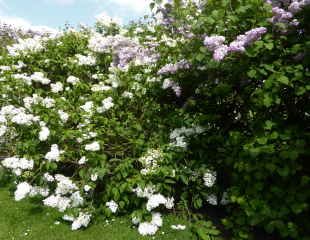
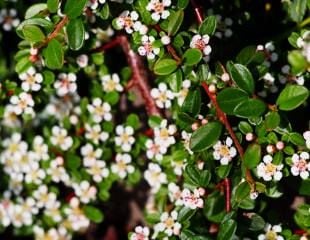

10 Best shrubs and hedges for wildlife and pollution busting
Did you know that some shrubs and hedges can actually compact some effects of pollution and particulates?
The shrubs listed here have health benefits in combating the effects of pollution and are attractive to wildlife. In the images above the shrubs all look nice, but only one is good for bees and pollution absorption, the centre image, namely Cotoneaster.
I suggest some shrubs which are rated either as wildlife friendly, or to trap pollutants, and some do both.
We are aware of the adverse effects of car pollution on health. If you are living near a major road, or a road which has become busier and car pollution concerns you, there are steps you can take to ameliorate the effects. We have long known the benefit of trees and now scientists have discovered that hedges can help improve air quality alongside urban roads.
Trees absorb pollutants, but hedges are physically lower, growing as they do at car and traffic level. Research by the University of Sussex and from the RHS, has also determined which hedges are best at absorbing pollutants. Certain shrubs, predominantly those with larger leaves, rough or hairy leaves, trap the most pollutants. Ideally, to be most effective, the hedge needs to be 1.5-2m high and a density of 1m.
Recommended shrubs to absorb pollutants by creating a green barrier include : Cotoneaster, Hawthorn, Cupressus macrocarpa, Elaeagnus x ebbingei, Common Beech, English Yew, and Viburnum Tinus. These are both evergreen and deciduous shrubs and would make an attractive mixed hedge or a simple line of Common Beech, (Fagus sylvatica) can look very stylish and help to soak up pollutants. There are more illustrated below.
Mix and match the shrubs below to make a varied and interesting hedge which is colourful, interesting to the birds, and will help clean up the air around your home. If you live on a busy road, planting these shrubs to form a hedge along your front boundary will help to absorb particulates. Shrubs with berries are always popular with birds.
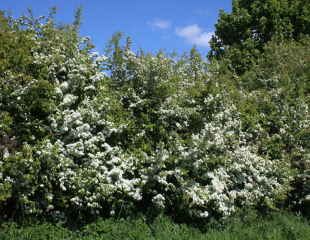
Hawthorn, Crataegus monogyna,
Our native Hawthorn is a great choice for a hedge or mixed shrub area. It is listed as effective particulate screening and also much loved by birds, especially Blackbirds, Redwings, Fieldfares, Chaffinches Starlings and Greenfinches .
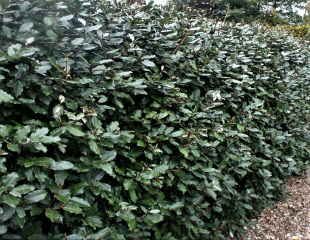
Elaeagnus × ebbingei
This is an evergreen tough grow anywhere shrub, ideal if you have poor growing conditions. The dense, large, somewhat rough leaves are pollutant trappers. It's not the most exciting of hedges, but very functional it will grow in sun and partial shade, is very hardy and will tolerate salt laden air.
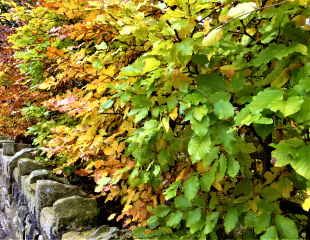
Common beech
Called the Common Beech, Fagus sylvatica makes acolourful deciduous hedge. The vivid green new spring growth becomes lush in the summer, followed by a spectacular autumn colour. The brown leaves are usually remain on the branches over winter. Birds love the cover and frequently nest in it.
A super Shrub Cotoneaster franchetti

The RHS has undertaken significant research into the beneficial effects of shrubs and plants in urban gardens, which include absorbing pollution, buffering road-noise, and aesthetics of an attractive front garden.
Enter Cotoneaster franchetii a "super-plant" a sort of broccoli of the shrub world. Further research by the RHS shows of all shrub choices C. franchetii is the top-rated to improve air conditions because of its superpowers in trapping airborne particles. Its dense canopy and rough hairy leaves are key to improving air quality. The RHS has established that C.franchetti will trap 20% more emissions than other hedges they tested. It is thought that 1m length of dense hedge will mop up in a week the emissions equivalent to those produced by a car travelling 500 miles.
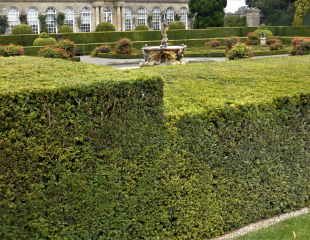
English yew
English Yew a traditional hedging plant of many a stately home (this is Blenheim Palace.) The RHS research found yew helped to ward off pollution. It is relatively slow growing stylish evergreen shrub.
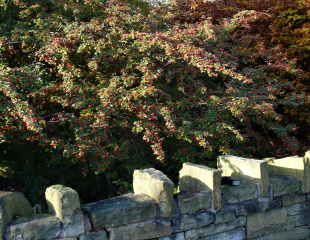
Cotoneaster
A great wildlife shrub which also helps to trap and fend off pollution Cotoneaster is a tough grow anywhere shrub. It has many white flowers in spring which are attractive to bees, followed by berries which the blackbirds strip off in the autumn.
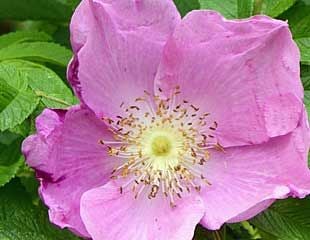
Rosa Rugosa
A tough easy to grow rose, it produces lots of brightly coloured hips in the autumn. These provide food for Blackbirds, Mistle Thrushes and Fieldfares.
It will tolerate salt spray, making it suitable for coastal gardens.
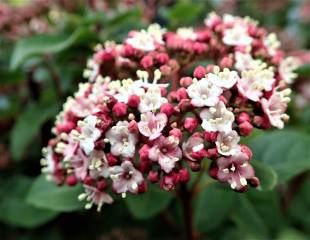
Viburnum tinus
Another shrub recommended in the RHS research to help deal with pollution is Viburnum tinus. This is an easy to grow, tough, evergreen shrub which has attractive flowers in late winter/early spring.
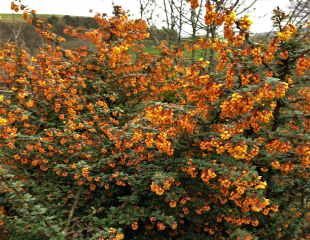
Berberis
The RSPB also recommends Berberis, which is a spring flowering evergreen shrub with thorny branches loved by birds for berries and safe nesting. This illustrated is Berberis darwinii.
It makes a colourful hedge and the thorns provide security against unwelcome visitors.
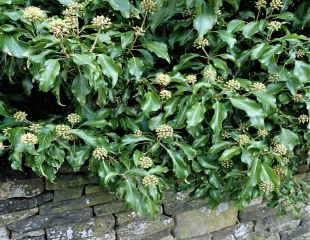
Common Ivy
Saved the best for last. The common Ivy Hedera helix when it matures is one of the best wildlife hosts in the garden. It flowers in late autumn and winter, providing nectar for many insects ahead of hibernation, and it provides shelter. The woodland trust lists all its many properties and the University of London rate its air cleaning qualities.
